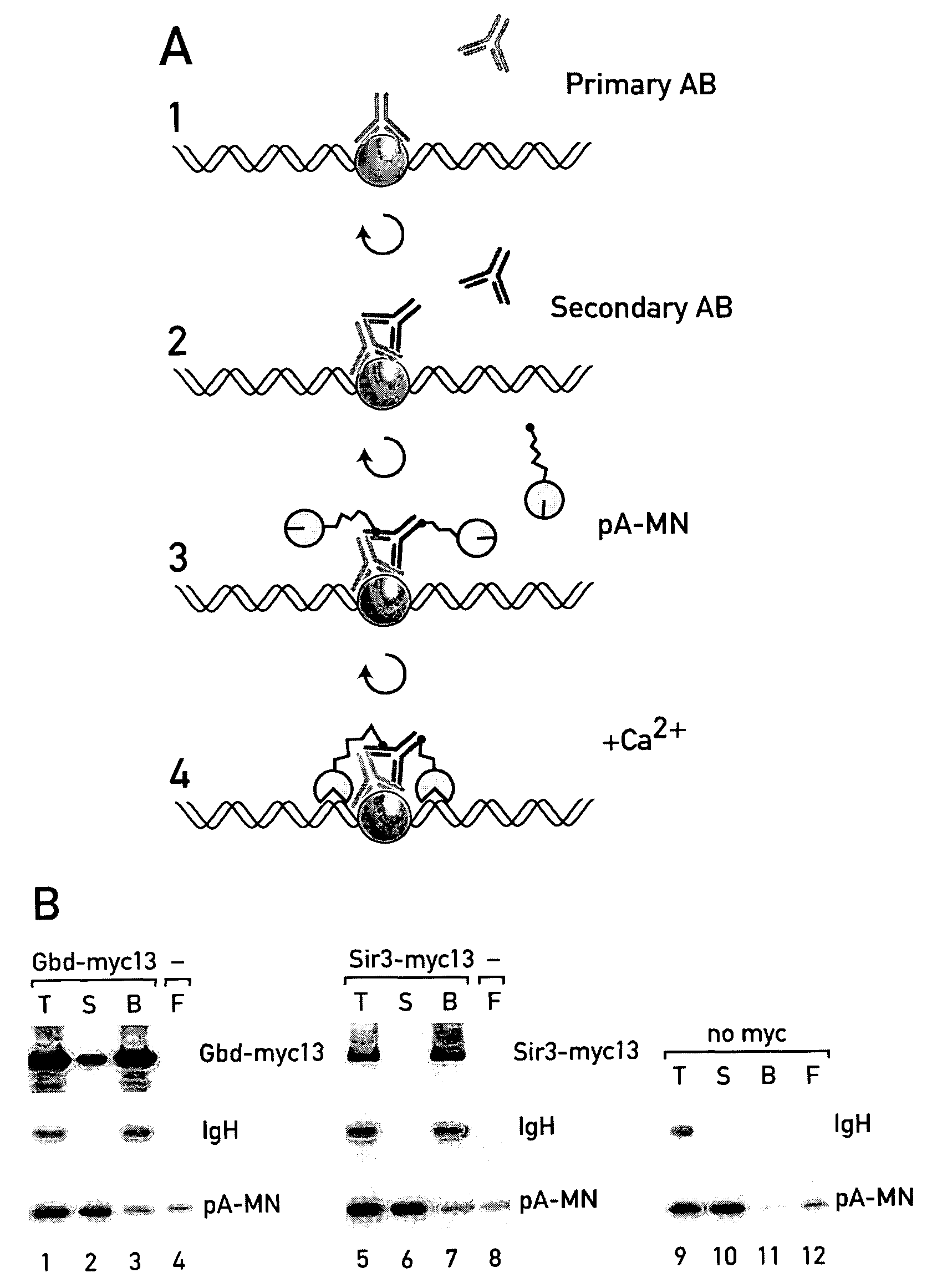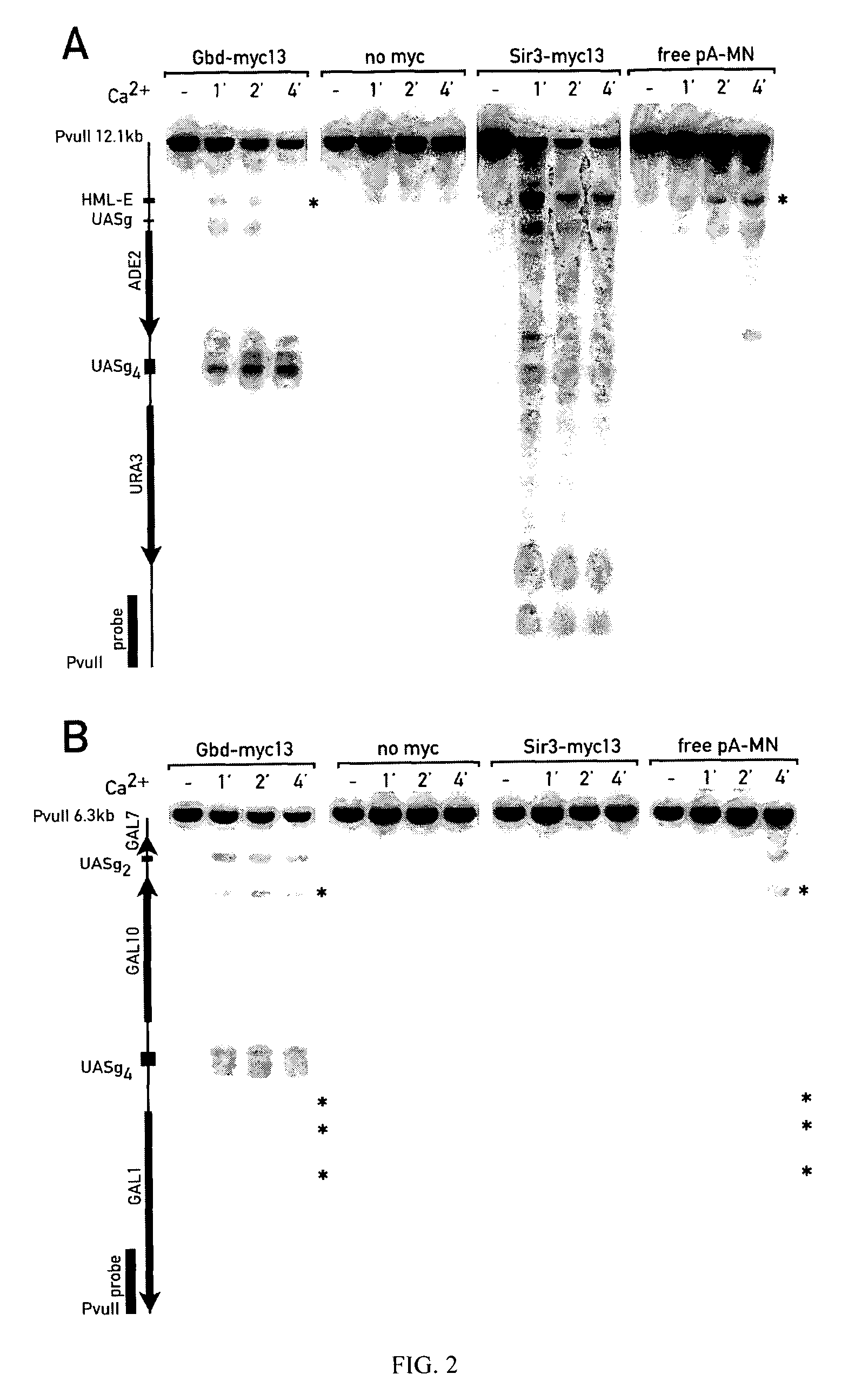Mapping of proteins along chromatin by chromatin cleavage
a technology of chromatin cleavage and protein mapping, applied in the field of cell biology, can solve the problems of affecting the chip method, affecting the stability of the chip, and affecting the stability of the chromatin protein,
- Summary
- Abstract
- Description
- Claims
- Application Information
AI Technical Summary
Benefits of technology
Problems solved by technology
Method used
Image
Examples
example 1
Genomic Mapping of Chromatin Proteins
[0229]To map the genomic interaction sites of chromatin proteins two related methods were developed and experimentally explored in Saccharomyces cerevisiae. The ChIC method (chromatin immuno-cleavage) consists of tethering to specifically bound antibodies a fusion protein (pA-MN) consisting of micrococcal nuclease (MN) and staphylococcal protein A. The nuclease is kept inactive during the tethering process (no Ca2+). The ChEC method (chromatin endogenous cleavage) consists of expressing fusion proteins in vivo, where MN is C-terminally fused to the proteins of interest. The specifically tethered nucleases are activated with Ca2+ ions to locally introduce double-stranded DNA breaks. It is demonstrated that ChIC and ChEC map proteins with a 100-200 bp resolution and excellent specificity. One version of the method is applicable to formaldehyde fixed nuclei, another to native cells with comparable results. Among various model experiments, these meth...
example 2
‘Solid State’ SS-CHIC
[0305]In the ChIC procedure detailed in example 1, the binding and washings steps were carried out in suspension by centrifugation (Schmid et al., 2004). To shorten processing times, improve specificity (better washing) and achieve a number of additional improvements (below), the inventors have carried out the ChIC procedure by ‘solid-state’ (ss-ChIC), where chromosomes, nuclei or permeabilized cells are attached to glass coverslips. This is akin to staining protocols for immunofluorescence (IF, FIG. 7). In contrast to IF, it is necessary to reversibly attach large amounts of DNA (about 10 μg of DNA) per coverslip to allow Southern blotting. It is however to be noted, that it is possible to work with less material by using PCR amplification (see example relating to the genome-wide procedure).
[0306]Preliminary experiments established that polylysine-coated coverslips were found to be inadequate for ss-ChIC, due to loss of material during the washing steps. Differ...
example 3
Genome-Wide (gw) ChIC & ChEC
[0319]Indirect end-labeling and Southern blotting are used to map the genomic locations of chromatin proteins in the procedures of example 1. The inventors have extended this method to a genome-wide (gw) analysis, where tiling microarrays, encompassing entire genomes or chromosomes, are probed with gw-probes.
[0320]To prepare gw-probes, it is necessary to isolate the DNA fragments abutting MN cuts (boxed, FIG. 8A). The restriction enzyme Mbo I, a frequent cutter, is used to trim the DNA flanking MN-cuts (depicted). The isolation and amplification protocol of this flanking DNA is outlined in panels B & C of FIG. 8 (see also legend of FIG. 8).
PUM
| Property | Measurement | Unit |
|---|---|---|
| time | aaaaa | aaaaa |
| temperature | aaaaa | aaaaa |
| concentration | aaaaa | aaaaa |
Abstract
Description
Claims
Application Information
 Login to View More
Login to View More - R&D
- Intellectual Property
- Life Sciences
- Materials
- Tech Scout
- Unparalleled Data Quality
- Higher Quality Content
- 60% Fewer Hallucinations
Browse by: Latest US Patents, China's latest patents, Technical Efficacy Thesaurus, Application Domain, Technology Topic, Popular Technical Reports.
© 2025 PatSnap. All rights reserved.Legal|Privacy policy|Modern Slavery Act Transparency Statement|Sitemap|About US| Contact US: help@patsnap.com



